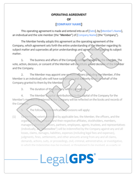What to Do When You Fail a Health Inspection
Your café is buzzing with customers when a health inspector arrives, clipboard in hand. A week later, a failed inspection report lands, citing...
5 min read
LegalGPS : Sep. 25, 2025
You’re reviewing payroll for your small retail store when you notice a mistake: your employees’ overtime has been paid at their regular rate, not the required 1.5x rate. This error could mean thousands in back wages, Department of Labor (DOL) fines up to $2,074 per violation, and angry employees threatening lawsuits. Miscalculating overtime is a costly mistake that can erode trust and destabilize your business if not corrected swiftly.


Legal GPS Pro
Protect your business with our complete legal subscription service, designed by top startup attorneys.
This guide walks you through how to fix wrong overtime calculations, offering a clear, actionable plan to comply with laws, compensate employees, and prevent recurrence. From identifying errors to rebuilding trust, we’ll cover five key steps, packed with real-world examples and practical “Pro Tips” to protect your business. Whether you’re a startup founder, small business owner, or freelancer with staff, let’s get your payroll right.

Employment Agreement
Craft a solid Employment Agreement with this guide covering essential terms protections and best practices for employers.
Trusted by 1,000+ businesses to safeguard their LLCs.
Your first step is to pinpoint where and how you’ve miscalculated overtime to understand the scope of the problem.
Review payroll records for the past 2–3 years (the typical statute of limitations) using software like Gusto ($40/month). Check for errors, such as paying overtime at 1x instead of 1.5x the regular rate, misclassifying non-exempt employees as exempt, or excluding bonuses from overtime calculations. Verify compliance with the Fair Labor Standards Act (FLSA) and state laws—some states, like California, require daily overtime after 8 hours.
Document errors in a Google Sheets file: affected employees, incorrect rates, hours, and dates. Calculate the total underpayment to estimate liability. The Department of Labor provides FLSA overtime rules to guide your review.
Jane, a café owner, discovered her payroll system paid overtime at regular rates for 10 employees over 18 months. Reviewing Gusto records, she found 500 hours of underpaid overtime, totaling $7,500. Jane noted each error in a spreadsheet, confirming the issue stemmed from a software misconfiguration.
Identifying errors, as Jane did, gives you a clear picture of the damage, setting the stage for corrections.
Research state overtime laws in your Google Docs notes, as they may exceed FLSA requirements (e.g., California’s daily overtime). Use your state’s labor department website to confirm rules, ensuring your calculations align with both federal and state standards.
Overtime errors carry legal and financial risks, so consult a professional to assess liabilities and plan corrective actions.
Hire an employment lawyer or HR consultant ($200–$500/hour) to review your payroll records and errors. They’ll estimate back wages (e.g., $7,500 in underpayments) and potential DOL penalties ($2,074 per willful violation). They’ll also check if employees could claim liquidated damages (double the back wages) or legal fees in a lawsuit. The consultant will recommend steps, like notifying employees or self-reporting to the DOL to reduce penalties.
Save their advice in a Google Drive folder and agree on a timeline, like 30 days, for corrections.
Ask your consultant for a written estimate of back wages, penalties, and legal risks ($100–$200 extra). Store it in Google Docs to budget for payments and prioritize fixes, ensuring you’re prepared for financial and legal outcomes.
Expert guidance helps you navigate the legal maze and minimize costly mistakes.
Compensating employees for underpaid overtime is your next step to resolve the error and avoid lawsuits.
Recalculate overtime at 1.5x the regular rate for all affected hours, including bonuses or shift differentials if required. For example, an employee earning $20/hour should get $30/hour for overtime. Use Gusto to run calculations, ensuring accuracy. Issue payments via direct deposit or checks, including a letter explaining, “We found an error in overtime calculations and have paid $1,200 for hours from January 2024–May 2025.”


Legal GPS Pro
Protect your business with our complete legal subscription service, designed by top startup attorneys.
Have employees sign an acknowledgment of payment to close the issue. Document payments and letters in Google Drive for DOL audits.
Mike, a retailer, underpaid 8 employees $10,000 in overtime over 2 years. He recalculated wages in Gusto, issued checks with a clear explanation, and had employees sign receipts. Mike paid within 30 days, avoiding a DOL complaint. His transparency resolved the issue cleanly.
Paying back wages, as Mike did, shows good faith and reduces legal risks, keeping employees satisfied.
Add 1–2% interest to back wage payments, calculated in Google Sheets, to account for delays (e.g., $100 interest on $5,000). This voluntary step demonstrates fairness and may deter lawsuits, as employees see you’re going beyond the minimum.
Fixing the error isn’t enough—update your payroll systems to ensure accurate overtime calculations moving forward.
Switch to or configure payroll software like Gusto to automate overtime at 1.5x rates, factoring in state rules. Train HR or managers on FLSA and state laws, using a 1-hour session with DOL resources—cover exempt vs. non-exempt status and bonus inclusions. Conduct monthly payroll audits in Gusto to catch errors early, reviewing 5–10 employee records.
Update employee handbooks with clear overtime policies, like “Overtime paid at 1.5x for hours over 40/week.” Save training logs and audit reports in Google Drive.
Set up Gusto to flag overtime hours automatically, alerting you when employees exceed 40 hours/week. Test settings monthly to ensure accuracy, reducing manual errors and keeping your payroll compliant with minimal effort.
Updated processes prevent repeat errors, saving time and legal headaches.
Overtime errors can erode employee morale, so communicate transparently to restore confidence and maintain a positive workplace.
Notify employees via email or meetings within 24 hours of issuing back wages, stating, “We corrected an overtime calculation error and paid all owed wages.” Apologize sincerely and outline new measures, like “We’ve upgraded our payroll system to ensure accuracy.” Offer a Q&A session or a Google Forms link for questions, addressing concerns promptly.
Recognize employee patience with a small gesture, like a $50 gift card or extra break time, to boost morale.
Laura, a bakery owner, underpaid $8,000 in overtime to 12 employees. After paying back wages, she emailed staff, apologized, and explained her new Gusto system. She held a Q&A and gave each employee a $25 coffee voucher. Laura’s openness rebuilt trust, and staff morale recovered quickly.
Transparency, like Laura’s, shows employees you value fairness, strengthening loyalty.
Draft a Google Docs script for your employee notification: “We regret the error, have paid all wages, and implemented [fixes].” Practice it to convey sincerity. This ensures consistent messaging, reducing misunderstandings and reinforcing trust.
Miscalculating overtime is a serious mistake, but with the right approach, you can correct it and strengthen your business. By identifying errors, consulting experts, paying back wages, updating processes, and rebuilding trust, you’ll comply with laws and keep employees happy. Start today by auditing your payroll system—accuracy is your best defense.
Have you faced overtime errors or worry about payroll? Share your story in the comments or reach out. Your business deserves fair pay—let’s keep it compliant.
The biggest question now is, "Do you need a lawyer for your business?” For most businesses and in most cases, you don't need a lawyer to start your business. Instead, many business owners rely on Legal GPS Pro to help with legal issues.
Legal GPS Pro is your All-In-One Legal Toolkit for Businesses. Developed by top startup attorneys, Pro gives you access to 100+ expertly crafted templates including operating agreements, NDAs, and service agreements, and an interactive platform. All designed to protect your company and set it up for lasting success.

Legal GPS Pro
Protect your business with our complete legal subscription service, designed by top startup attorneys.
|
Premium Template
Single-use Template |
Legal GPS Pro
Unlimited Access, Best Value |
|
|
| Choose Template | Learn More |
| Trusted by 1000+ businesses | |

Your café is buzzing with customers when a health inspector arrives, clipboard in hand. A week later, a failed inspection report lands, citing...

You’re managing your small bakery when an employee emails, demanding to see their personnel file by next week. You’re unsure what’s required, what...

You’re running a small retail store when a trusted employee approaches you, requesting leave under the Family and Medical Leave Act (FMLA) for a...